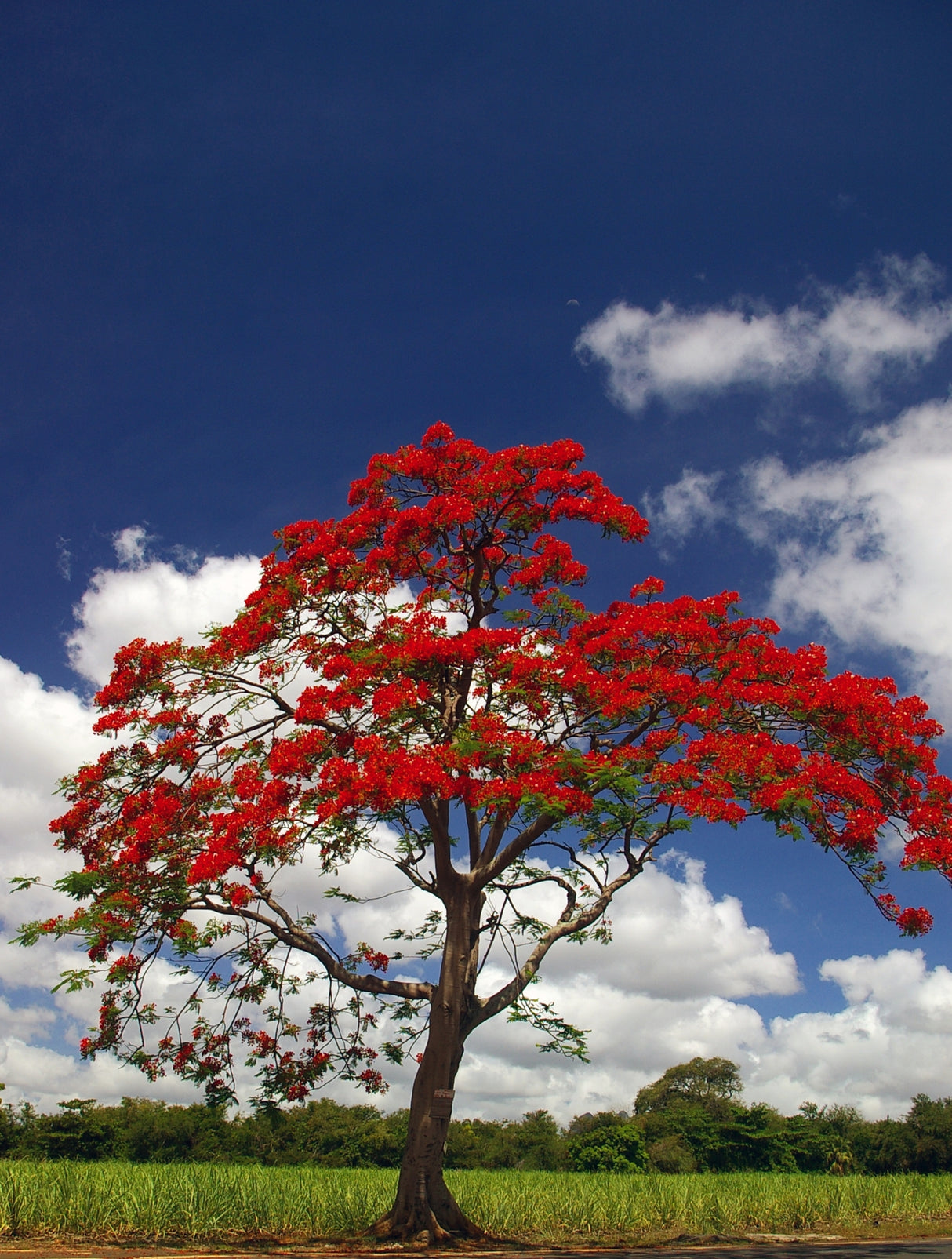Brachychiton acerifolius
The Brachychiton acerifolius, or Flame Tree, is a spectacular deciduous tree native to Australia, renowned for its brilliant scarlet-red flowers that bloom in late spring to early summer. These blooms appear on bare branches, creating a fiery display before the emergence of fresh green foliage. Growing up to 10–20 meters tall, this striking tree is an excellent choice for feature planting, street trees, or large landscapes.
Adaptable and hardy, the Flame Tree thrives in a range of climates, making it a popular choice for adding bold seasonal color to gardens and urban spaces.
Specifications:
- Height: 10–20 meters
- Width: 5–10 meters
- Native to: Eastern Australia
- Foliage: Glossy green, lobed leaves; deciduous
- Growth rate: Moderate
Conditions:
- Soil: Prefers well-drained, fertile soils; tolerates sandy, loamy, or clay types
- Light: Full sun
- Water: Moderate; drought-tolerant once established
- Climate: Thrives in temperate, subtropical, and tropical regions
Additional Features:
- Flowers: Vibrant scarlet-red bell-shaped blooms appearing in late spring to early summer
- Uses: Ideal for feature planting, shade trees, or street trees in large gardens or urban landscapes
- Spacing: Plant 8–10 meters apart for individual growth or groupings
- Low Maintenance: Requires minimal pruning; shape lightly as needed
- Pest Resistance: Generally resilient with basic care
- Wildlife Attraction: Flowers attract birds, bees, and pollinators
- Seasonal Appeal: Spectacular flower display on bare branches; fresh green foliage in summer
The Flame Tree is an iconic and vibrant tree, perfect for creating dramatic focal points in landscapes while providing habitat for wildlife and seasonal beauty.
The Benefits Of Buying An Advanced Tree
The Process Of Transplanting A Mature Tree
Identify the Tree's Root Zone
Identify the Tree's Root Zone
Before you begin, it's essential to identify the root zone or root ball of the tree. This is the area where the majority of the tree's feeder roots are located. It is typically estimated as 1 foot of root ball diameter for each inch of tree trunk diameter.
Prune the Roots
Prune the Roots
Root pruning should occur a few months before the actual move, ideally in the dormant season. This involves cutting a trench around the root zone to encourage the growth of new feeder roots, which will help the tree to establish itself in its new location.
Prepare the Tree
Prepare the Tree
Prior to digging, prune dead or excessive branches from the tree. This reduces the tree's overall mass, making it easier to handle, and decreases water loss post-transplant.
Dig Around the Root Ball
Dig Around the Root Ball
After determining the root ball's size, begin digging around it. Try to retain as much soil around the roots as possible. The depth should ideally get under the root system but be feasible for lifting.
Undercut the Root Ball
Undercut the Root Ball
Once you've dug around the periphery of the root ball, begin undercutting to sever the remaining roots beneath it.
Lift the Tree
Lift the Tree
With the root ball freed, carefully lift the tree out of the hole. For large trees, this will likely require machinery like a tree spade or crane. Always lift the tree by the root ball, not the trunk.
Prepare the Tree for Transport
Prepare the Tree for Transport
Once the tree is out of the ground, it's critical to protect the root ball to prevent damage. Wrap it in burlap and secure it with twine, wire or steel basket. This not only holds the root ball together but also helps retain moisture.
Water the Root Ball
Water the Root Ball
Prior to transportation, water the root ball thoroughly to ensure the roots stay moist.
Transporting the Tree
Transporting the Tree
Load the tree carefully onto a truck or trailer for transport. The tree should be securely positioned to avoid damage during transit. The tree should ideally be planted in its new location as soon as possible to minimize stress and increase its chance of survival.


